Inside the massive global operation to split EY
Project Everest is being driven by EY’s global chief executive Carmine Di Sibio, who believes the move is inevitable and will eventually be emulated by consulting rivals Deloitte, KPMG and PwC.
At EY offices around the world, teams of partners and consultants are working around the clock on the biggest and most complex deal of their careers.
It involves raising $US30 billion ($43 billion) and splitting an organisation that employs more than 300,000 people across dozens of countries in half.
It is a complex transaction, one partner said, featuring roughly 70 global partnerships splitting in two and then one group forming a new company.
The client is, of course, EY, and the firm’s veteran corporate advisers are well aware of the sheer scale and risk they are taking in pushing forward with this decoupling.
The “operational separation” work is being done before a formal vote by the firm’s 13,000 partners that could lead to the biggest shake-up of the global professional services market in more than two decades.
If the separation works, EY’s rivals among the so-called big four – Deloitte, KMPG and PwC – will feel pressure to follow suit, senior executives at those firms say.
By extension, that could affect the nature of how almost $US200 billion of global consulting, auditing and accounting work is handled around the world. It could lead to massive audit-focused firms, and large consulting giants, such as Accenture, being able to pitch for work without worrying about running into regulations around auditor independence.
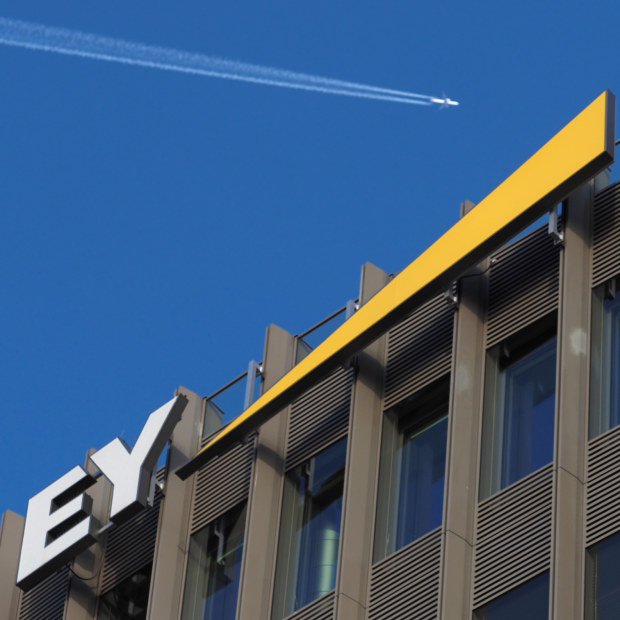
EY’s global leaders are trying to persuade the firm’s 13,000 partners worldwide that the consulting arm and the remaining audit business can both grow faster apart. Getty
The Australian Financial Review has been told about aspects of the internal project to split the firm, seen parts of a presentation outlining the overall governance and organisational structure of the project, and spoken to multiple partners and staff about their experience and views of the separation plans.
What has emerged is that the firm’s most senior partners – veterans of advising clients on how to restructure their organisations – have now turned that experience on the firm with an almost alarming level of enthusiasm
The result is a sprawling internal project with global, regional and local teams working to untangle a firm that can trace its namesake roots back the start of the 19th century.
The global operational split involves 28 global teams working to divide the multidisciplinary firm into a pure audit firm and an independent consultant that will list in the US.
These teams are working on splitting all aspects of the firm’s operations, including the finance, recruitment, legal, business development and risk functions. This is in addition to regional and country-level teams, steering committees and other groups working on other aspects of the massive plan to separate EY.
Adding to the pressure are fast approaching internal deadlines. EY’s leaders want to tell staff which firm they will be working in by July and to have completed the “operational separation” by November.
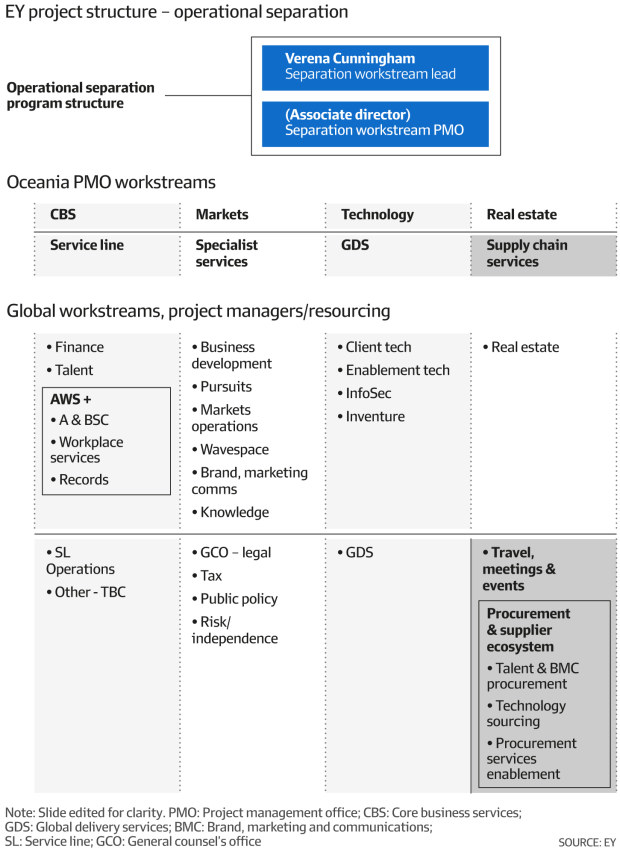
Project Everest slide outlining the workstreams that have been created to split the firm in two.
Project Everest
The firm’s partners, who generated about $US45 billion in revenue in financial 2022, have been mostly allocated to one of the outfits. About 6000 partners will stay with the audit partnership, and 7000 will head to the consulting company.
Project Everest, as the plan is known internally, aims to raise about $US30 billion that will be mostly distributed to partners in the form of windfall multimillion-dollar payments not seen in the sector since the turn of the century. EY will borrow about $US18 billion and is hoping to raise about $US11 billion through the float of a 15 per cent stake in the newly independent consulting arm.
The task has been complicated by the fact that the legal structure of the firm can vary markedly by country. This means each country expected to take part in the split has to be separated, with the various consulting arms then combined into one global company that can be floated. The firm’s China and Israel EY partnerships have already said they would not split their operations.
EY declined to comment formally for this article.
Project Everest is being driven by EY’s global chief executive Carmine Di Sibio, who believes the move is inevitable and will eventually be emulated by consulting rivals Deloitte, KPMG and PwC.
The other firms have publicly denied they are pursuing any similar view, but senior partners at these firms have told the Financial Reviewthat such a move is probably unavoidable. They point to increasing regulatory pressure around the conflicts that can arise in their corporate auditing work as their consulting arms move into even more varied services and corporate partnerships.
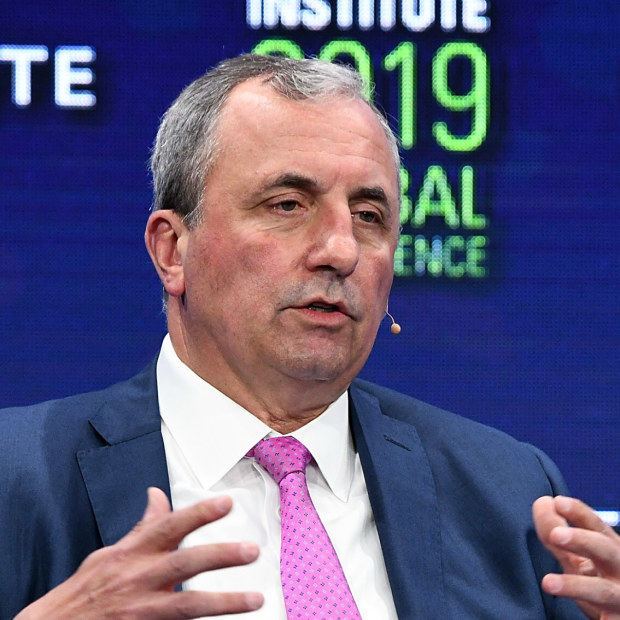
EY global chairman and CEO Carmine Di Sibio. Getty
The ambitious plan, which would reshape the auditing and consulting sectors, involves spinning off EY’s faster-growing consulting arm into a new company, referred to as “NewCo” internally, that would be floated on the US sharemarket. NewCo would offer services that include strategy, management consulting, transactions and tax advice, along with managed services.
The remaining firm, which is now being increasingly referred to as “New EY” internally, would offer corporate auditing, tax and sustainability advice. The tax work will include advising on the complicated taxation and valuation issues that arise during the audits of large companies. New EY, which had previously been referred to as “AssureCo”, would remain a partnership and retain the big four branding, while the newly established consulting business would take on a new brand.
The case for and against
Di Sibio and other EY partners have cited several reasons for the split. NewCo consultants would be free to advise and partner with technology giants that are being audited by EY such as Amazon, Google and Workday.
In turn, New EY will be freed of the conflicts and independence concerns that currently exist between the firm’s regulated auditing division and its consulting divisions. This will allow New EY auditors to cast a wider net for clients without worrying they will be restricting their fellow consultants from winning work.
Clients seem positive about the move. Nearly 60 per cent of about 300 surveyed Australian consulting clients said they would be more likely to buy EY’s audit services if it went through with its proposed split, according to a survey by Source Global Research found.
The firm’s auditing leaders are also excited by the prospect of being freed from conflict restrictions. EY’s local head of audit and assurance, Glenn Carmody, told the Financial Review last December the split would allow the resulting accounting firm to tender for “most audits that come to market” and nab clients from rivals who may have too many conflicts of interest to pitch for the work.
But doubts remain. Last October, a group of 150 retired EY partners from the US outlined their concerns about the move in a letter to the firm’s leadership, reported by the Financial Times.
The former partners, concerned about the firm’s ability to fund their ongoing pension payments, said splitting EY would create two weaker firms. They warned a separate audit business “will have a significantly lower level of earnings”, may struggle to attract new partners and staff and may have to redevelop specialist consulting skills that are now required to carry out complex audits.
They also questioned the firm’s plan to split its tax business between the audit and consulting arm.
“We believe such bifurcation [of the tax division] will benefit neither AssureCo nor Newco,” the retired partners wrote. “AssureCo will likely lose valuable resources necessary to respond to audit client tax matters. Newco will lose an important source of knowledge and on-the-job training for staff working in the tax area [as many of these resources grew up, and continue to work, on audit assignments].”
In response, EY told retired US partners it aimed to ensure the pension plan was funded as part of the transaction, estimated by the former partners to be a liability worth about $US7.5 billion.
The firm is also seeking to create a consistent way for partners from around the world who have retired since FY22 to participate financially in the split.
Delayed timeline
The timeline of Project Everest has slipped continually since being revealed prematurely last May. A vote by the firm’s 13,000 partners on whether to approve the split is being earmarked for April, but the Financial Reviewhas been told the internal expectation was that the timing of this critical vote could extend to as late as June.
“I do see potential [further] delays because the deal is complicated,” Di Sibio told a US summit last week.
The firm’s current partners have a strong financial incentive to vote for the split. Modelling from last year estimated audit partners could be in line for a typical cash payout of $US2 million, while consulting partners could receive shares in a newly floated advisory company worth up to $US8 million, accessible over five years.
Those details – critical to partners – remain in flux because of changing market conditions. In addition, the actual amount individual partners may get as part of the deal will vary markedly between countries.
The US market for initial public offerings has cooled since the existence of Project Everest was first revealed, which will affect the valuation put on NewCo and the amount raised by any float. Interest rates have also increased since mid last year, increasing the cost of debt. Di Sibio also said last week that markets would have to freeze up completely to derail the split.

EY’s US chairman and managing partner, Julie Boland, will become the head of “New EY”.
EY sources believe that even though the valuation may vary, there will always be an appetite in the sharemarket for companies that generate steady cash earnings such as the mooted NewCo.
Vote outcome
Although EY partners in Australia vary dramatically in their level of engagement with Project Everest, they told the Financial Reviewthey expect the partner vote will likely approve the split.
In addition to the detailed “soft separation” currently under way, the December announcement that Di Sibio would run the newly independent consulting business was considered to be a key sign internally that top leadership expects partners to vote in favour of separating. Julie Boland, EY’s US chairman and managing partner, was announced as the head of New EY at the same time.
Di Sibio’s appointment means that the 59-year-old will likely continue at the firm beyond its usual retirement age of 60. (EY’s Australian arm abandoned the requirement for partners to retire at 60 in 2020).
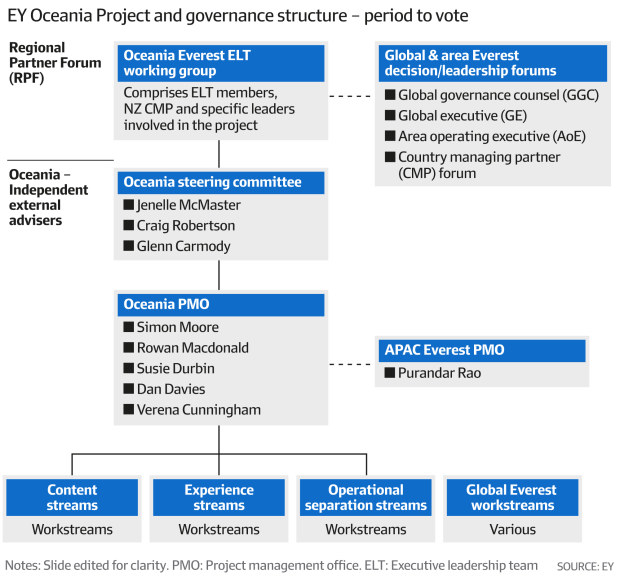
The EY Oceania governance structure involves senior local leaders from the firm’s executive leadership team, including regional managing partner and chief executive David Larocca, deputy CEO Jenelle McMaster and chief operating officer Craig Robson.
The Oceania project management office includes strategy and transactions partner Simon Moore, financial services partner Rowan Macdonald, workforce advisory partner Susie Durbin, and New Zealand-based partner Verena Cunningham. These teams may change over time, the Financial Review has been told.
Cunningham is also leading the firm’s Oceania separation stream. In addition to the separation work, there are also large streams of work the firm’s intellectual property and the actual “global [Project] Everest” work.
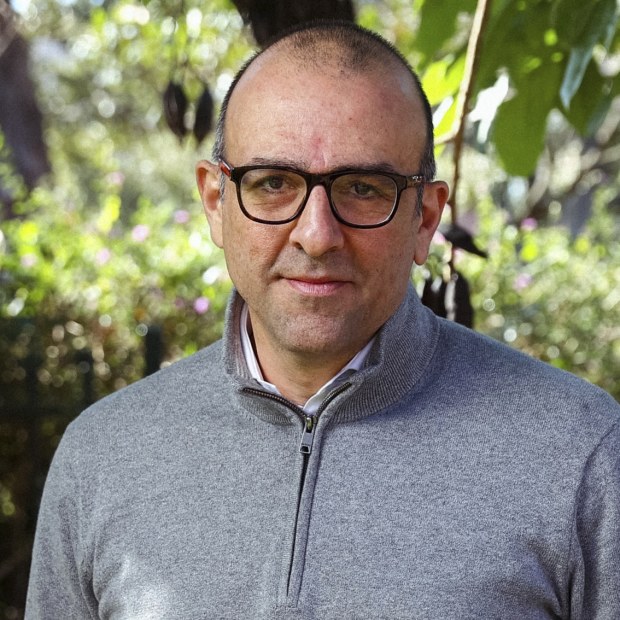
EY Oceania managing partner and CEO David Larocca.
Staff have received limited information about what the split will mean for them personally. In a local briefing by McMaster and Robson held late last year, staff were told that no redundancies were planned as part of the split, and they would not be required to reapply for their positions.
A separate local staff briefing from late last year acknowledged that hiring had slowed at the local firm as demand for services tapered before Christmas. This was put down to a broader slowdown in the economy.
Since then, EY’s US arm has cancelled midyear bonuses and slowed hiring, while the UK partnership has also reportedly cracked down on expenses across the operation.
Locally, EY performed well in the six months to December, according to a source, however work has slowed in areas critical to the firm such as the financial services sector.
This year has started reasonably well, and although staff recruitment has slowed, the firm is actively recruiting partners from rivals, the Financial Review was told. The planned split, along with lucrative remuneration, are proving to be an enticing lure for many of these senior recruits.
Find out the inside scoop about Accenture, Deloitte, EY, KPMG, PwC and McKinsey. Sign up to our weekly Professional Life newsletter.


